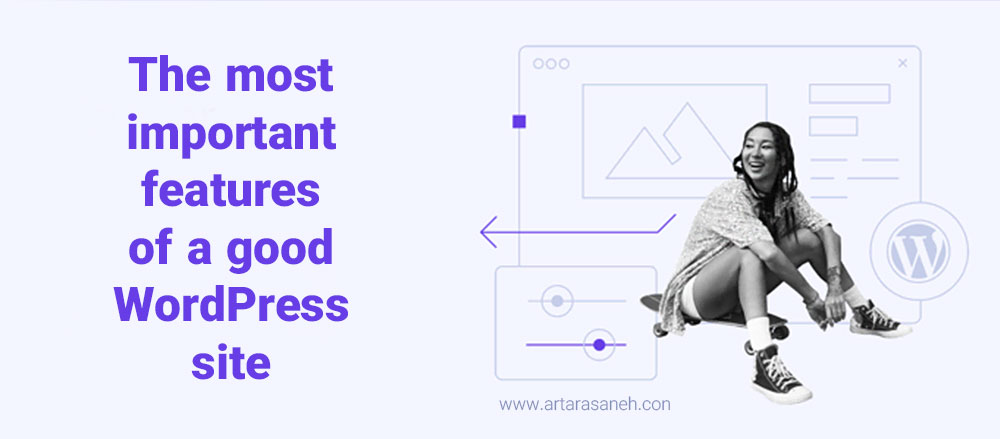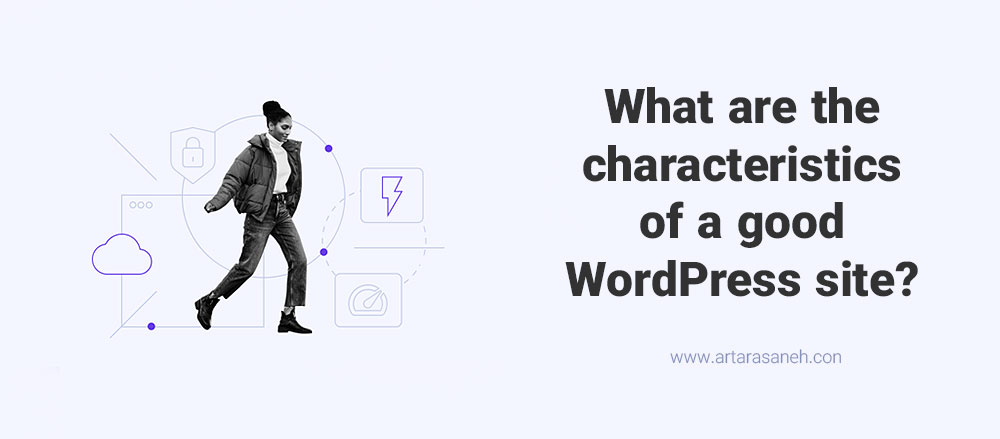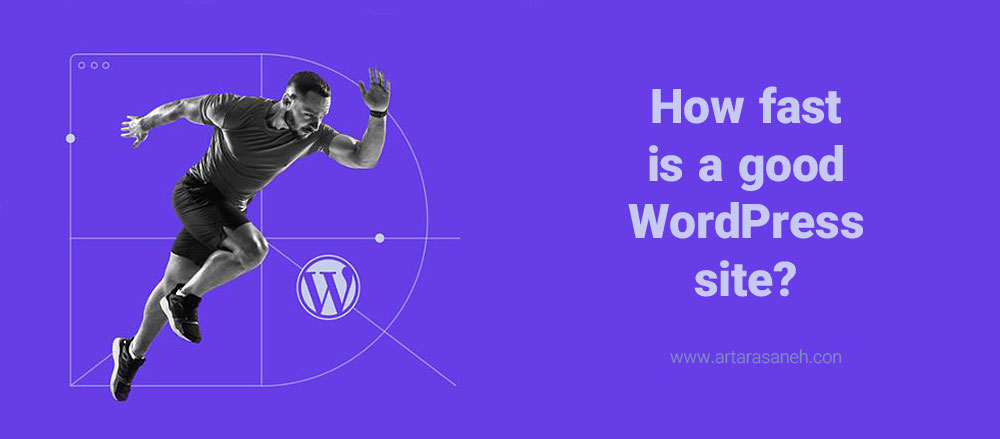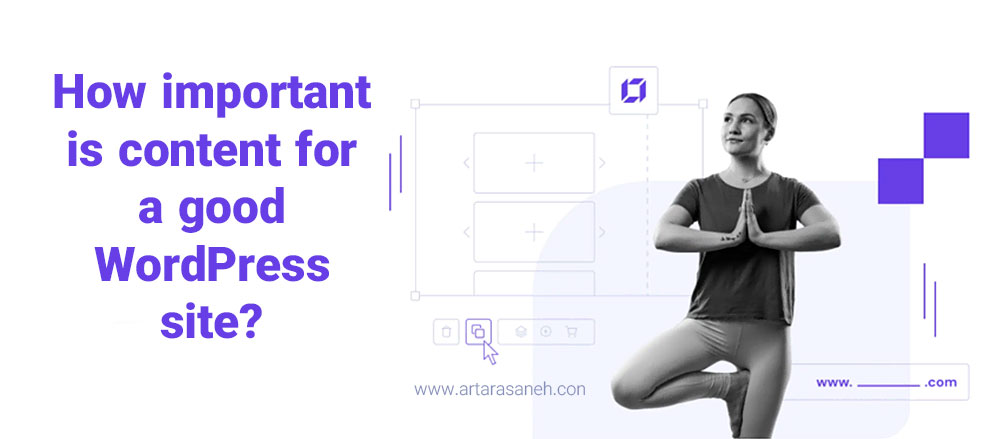
A good WordPress site possesses several key features that contribute to its functionality, usability, and overall success. As one of the most popular content management systems, WordPress offers a vast array of tools and plugins to create powerful websites. Due to its many features and advantages, WordPress is considered as one of the usual options for a cheap site and خرید سایت a store and company.
Features of a WordPress site
Here's an introduction to some essential features of a good WordPress site:
Responsive Design: A good WordPress site is responsive, meaning it adapts to different screen sizes and devices, such as desktops, laptops, tablets, and smartphones. This ensures a seamless user experience regardless of the device being used.
User-Friendly Navigation: The site should have a clear and intuitive navigation menu, making it easy for visitors to find the information they seek. Logical organization and a user-friendly menu structure are essential for a positive user experience.
High-Quality Content: Content is king, and a good WordPress site should have valuable, engaging, and well-structured content. This includes well-written articles, images, videos, and other media that are relevant to the site's purpose and target audience.
Fast Loading Speed: Speed is crucial for user satisfaction and search engine rankings. Optimizing images, using caching plugins, and choosing a reliable hosting provider are some ways to enhance the loading speed of your WordPress site.
SEO-Friendly: A good WordPress site is optimized for search engines, making it easier for potential visitors to find it through search queries. This involves using appropriate keywords, meta tags, and creating an SEO-friendly URL structure.
Security Measures: WordPress sites can be vulnerable to security breaches, so implementing security measures is essential. Regularly updating WordPress core, themes, and plugins, using strong passwords, and installing security plugins can help protect your site.
Contact and Feedback Options: Including contact forms or other means for visitors to get in touch is crucial for user engagement and customer support. Feedback forms allow visitors to express their opinions and suggestions, improving your site over time.
Social Media Integration: Social media is a powerful tool for driving traffic and engaging with your audience. Integrating social media sharing buttons and displaying social media feeds on your site can help increase its visibility.
Opt-in Forms for Email Marketing: Building an email list is vital for marketing purposes. Including opt-in forms to collect email addresses and integrating them with email marketing services can help you build a loyal subscriber base.
Mobile App Integration: If you have a mobile app related to your WordPress site, integrating it seamlessly can enhance user experience and encourage app downloads.
Analytics and Tracking: Incorporating analytics tools like Google Analytics allows you to monitor site traffic, user behavior, and other important metrics. This data can help you make informed decisions to improve your site's performance.
Accessibility: A good WordPress site is designed to be accessible to all users, including those with disabilities. Ensuring compliance with web accessibility standards is essential for inclusivity and usability.
Remember, these are just some of the fundamental features of a good WordPress site. Depending on your site's specific goals and target audience, additional features and customization may be necessary to create an outstanding online presence.
The most important features of a good WordPress site

A good WordPress site combines the core features of a successful website with the unique advantages of the WordPress platform. Here are the most important features that contribute to a well-functioning and effective WordPress site:
User-Friendly Content Management: WordPress offers an intuitive and easy-to-use content management system, allowing website owners and administrators to update and publish content without technical expertise.
Responsive Design: A good WordPress site is responsive and mobile-friendly, ensuring that it looks and functions well on various devices, including desktops, tablets, and smartphones.
Customizable Themes: WordPress provides a vast library of themes that allow users to customize the design and appearance of their website to match their brand and preferences.
Search Engine Optimization (SEO) Compatibility: With various SEO plugins and built-in features, WordPress allows users to optimize their site's content and structure for better search engine visibility.
Security Features: Implementing security plugins and regular updates to the WordPress core, themes, and plugins helps protect the site from potential security vulnerabilities.
Plugin Support: WordPress has a vast ecosystem of plugins that add extra functionality to the site, such as contact forms, social media integration, analytics tools, and more.
Fast Loading Speed: Optimizing the site's performance through caching, image optimization, and selecting a reliable hosting provider ensures fast loading times and improved user experience.
Built-in Blogging Capabilities: WordPress originated as a blogging platform, and it still offers robust blogging features, making it ideal for content marketing and engaging with the audience.
Social Media Integration: Integrating social media sharing buttons and displaying social media feeds helps increase the site's reach and allows visitors to easily share content.
User Registration and Membership: For sites with restricted content or community features, WordPress allows user registration and membership management.
Contact Forms and Lead Generation: Using contact form plugins, website owners can facilitate easy communication with visitors and generate leads for potential customers.
Analytics and Tracking Integration: WordPress supports integration with various analytics tools, providing valuable insights into user behavior and site performance.
E-commerce Integration: WordPress can be transformed into an online store with the help of e-commerce plugins, allowing users to sell products and accept payments.
Backup and Restore Functionality: WordPress plugins and hosting solutions offer backup and restore features, ensuring data safety and recovery in case of any issues.
Multilingual Support: With translation plugins, WordPress sites can be made multilingual to cater to a global audience.
By incorporating these essential features into their WordPress site, website owners can create a powerful and user-friendly online presence that meets their specific needs and goals.
What are the characteristics of a good WordPress site?

A good WordPress site exhibits several key characteristics that contribute to its effectiveness, user experience, and overall success. These characteristics encompass both the technical aspects and the content-driven elements of the site. Here are the essential characteristics of a good WordPress site:
Clear Purpose and Target Audience: The site has a well-defined purpose and caters to a specific target audience. It communicates its goals clearly and provides content and features tailored to meet the needs of its intended users.
Responsive Design: The site is responsive and adapts seamlessly to various screen sizes and devices, ensuring an optimal user experience across desktops, laptops, tablets, and smartphones.
User-Friendly Navigation: The site features intuitive and well-organized navigation, making it easy for visitors to find the information they need quickly and efficiently.
High-Quality Content: Content is of paramount importance. A good WordPress site offers valuable, relevant, and engaging content, including well-written articles, multimedia elements, and user-generated content where applicable.
Fast Loading Speed: The site loads quickly, reducing bounce rates and keeping users engaged. Optimization techniques like caching, image compression, and server improvements contribute to faster loading times.
Search Engine Optimization (SEO) Optimization: The site is optimized for search engines, incorporating relevant keywords, meta tags, and an SEO-friendly URL structure to improve its visibility in search results.
Security Measures: The site implements security best practices, including regular updates of the WordPress core, themes, and plugins, as well as the use of SSL certificates for data encryption.
Mobile App Integration: If relevant, the site integrates with a mobile app, enhancing user experience and providing additional functionalities.
Social Media Integration: The site incorporates social media buttons, allowing users to easily share content and connect with the brand across different social platforms.
Contact and Support Options: The site provides clear contact information and support options, such as contact forms or live chat, to facilitate communication with visitors and customers.
Analytics and Tracking: The site integrates with analytics tools to gather valuable data about user behavior, traffic sources, and other metrics, enabling data-driven improvements.
Accessibility: The site is designed with accessibility in mind, ensuring that all users, including those with disabilities, can access and use the site effectively.
Consistent Branding: The site maintains consistent branding elements, such as logo, colors, and typography, to establish a recognizable identity and foster brand trust.
Loading Error Handling: Proper handling of loading errors and 404 pages ensures that users are guided back to relevant content when they encounter broken links or unavailable pages.
Regular Updates and Maintenance: The site is regularly updated with fresh content and maintained to ensure all functionalities work as intended.
By incorporating these characteristics into their WordPress site, website owners can create a valuable, user-friendly, and engaging online platform that meets its goals and serves its target audience effectively.
How fast is a good WordPress site?

A good WordPress site should strive to achieve fast loading times to provide an optimal user experience and improve search engine rankings. The exact definition of "fast" can vary based on industry standards, user expectations, and the complexity of the site. However, as a general guideline, a good WordPress site should aim to load in:
Under 3 Seconds: Ideally, a good WordPress site should load within 2 to 3 seconds. Research shows that visitors tend to abandon a website if it takes more than 3 seconds to load.
1 to 2 Seconds for Key Content: Critical content above the fold, such as the main headline and call-to-action, should load even faster, ideally within 1 to 2 seconds.
Faster for Mobile: Given the increasing mobile usage, a good WordPress site should prioritize faster loading times for mobile devices, aiming for 1 to 2 seconds or less.
It's important to note that site speed can be influenced by various factors, including server performance, image sizes, caching, CSS and JavaScript optimization, and the use of content delivery networks (CDNs). Regularly monitoring site performance and making necessary optimizations can help achieve faster loading times.
Additionally, Google considers page speed as a ranking factor for search engine results, so a faster site can positively impact SEO and organic traffic. By using tools like Google PageSpeed Insights or GTmetrix, website owners can assess their site's speed and identify areas for improvement.
Ultimately, the goal is to create a fast WordPress site that provides a smooth user experience and keeps visitors engaged, leading to higher user satisfaction and improved conversion rates.
How important is content for a good WordPress site?

Content is of paramount importance for a good WordPress site. In fact, it can be argued that content is the backbone of any successful website, and WordPress, being a content management system, places significant emphasis on content creation and management. Here's why content is crucial for a good WordPress site:
User Engagement: Compelling and valuable content keeps visitors engaged and encourages them to spend more time on the site. Engaging content can lead to lower bounce rates and higher page views, indicating a positive user experience.
SEO and Organic Traffic: High-quality, relevant content is a key factor in improving search engine rankings. Search engines like Google prioritize sites with valuable content that matches users' search queries, leading to increased organic traffic.
Brand Building and Credibility: Well-crafted content helps build a brand's authority and credibility in its niche or industry. Providing valuable information and insights establishes the site as a reliable source of knowledge.
Conversion and Sales: Content plays a vital role in the conversion process. Informative and persuasive content can lead visitors to take desired actions, such as making a purchase, signing up for a newsletter, or contacting the business.
Social Media Sharing: High-quality and shareable content can go viral on social media platforms, significantly increasing the site's visibility and driving traffic.
Targeted Messaging: Tailored content allows the site to effectively communicate with its specific target audience, addressing their needs, interests, and pain points.
Content Marketing: Content is the backbone of content marketing strategies, such as blogging, email marketing, and lead generation. Valuable content attracts and retains customers, nurturing long-term relationships.
Updates and Freshness: Regularly updating the site with fresh content shows that the website is active and relevant, improving its overall performance in search engine rankings.
User Experience and Navigation: Content also affects the user experience and site navigation. Well-organized and structured content makes it easier for users to find information quickly.
Internal Linking: Creating valuable content allows for internal linking, where one page of the site links to another. Internal linking boosts SEO, improves user navigation, and helps distribute link equity.
To make the most of content on a WordPress site, it's essential to create content that is relevant, engaging, and optimized for search engines. Using relevant keywords, incorporating multimedia elements, and following best practices for content creation can help ensure the content's effectiveness in achieving the site's goals.
How is the security of a good WordPress site ensured?

Ensuring the security of a good WordPress site is essential to protect user data, maintain site integrity, and prevent unauthorized access or malicious attacks. Here are some key steps and practices to enhance the security of a WordPress site:
Regular Updates: Keep the WordPress core, themes, and plugins up to date. Developers regularly release updates to patch security vulnerabilities and improve overall performance.
Secure Hosting: Choose a reputable and secure hosting provider that employs robust security measures, such as firewalls, intrusion detection systems, and malware scanning.
Strong Passwords: Use strong, unique passwords for all user accounts, including administrators, editors, and contributors. Avoid common or easily guessable passwords.
Two-Factor Authentication (2FA): Implement two-factor authentication to add an extra layer of security, requiring users to provide a second form of verification, such as a code sent to their mobile device.
Limit Login Attempts: Limit the number of login attempts to prevent brute-force attacks. After a certain number of failed login attempts, lockout or temporary IP banning can be enabled.
Disable File Editing: Disable file editing within the WordPress admin panel to prevent attackers from modifying critical files from the dashboard.
Secure Sockets Layer (SSL) Certificate: Install an SSL certificate to enable HTTPS encryption, ensuring secure data transmission between the user's browser and the server.
Use Security Plugins: Install reputable security plugins that offer features like malware scanning, firewall protection, and login attempt monitoring.
Regular Backups: Schedule regular backups of the entire website, including the database and files, to ensure that data can be restored in case of a security breach.
File Permissions: Set appropriate file permissions to restrict access to critical files and directories on the server.
Disable Directory Listing: Prevent directory listing to avoid exposing sensitive information to potential attackers.
Disable XML-RPC: If not required, disable XML-RPC, as it can be a target for certain types of attacks.
Use Security Headers: Implement security headers, such as Content Security Policy (CSP) and X-Frame-Options, to mitigate various types of attacks.
Monitor and Audit Logs: Regularly monitor logs for suspicious activities and conduct security audits to identify potential vulnerabilities.
Educate Users: Educate all site users about security best practices, such as recognizing phishing attempts and avoiding downloading files from untrusted sources.
By implementing these security measures and maintaining a proactive approach to website security, a good WordPress site can significantly reduce the risk of security breaches and protect the integrity of the site and its users' data.
Conclusion
In conclusion, a good WordPress site possesses several critical characteristics that contribute to its effectiveness, user experience, and overall success. Content is a cornerstone of a successful WordPress site, providing valuable information, engaging users, and boosting search engine rankings. The site should be responsive, user-friendly, and fast-loading to cater to the diverse needs of visitors across different devices.
Security is of utmost importance in maintaining a good WordPress site, safeguarding user data and preventing unauthorized access. Regular updates, strong passwords, and security plugins help fortify the site against potential threats.
Additionally, the site's purpose should be clear, and it should be designed with the target audience in mind, ensuring that users can easily navigate and find the information they seek. Integration with social media and analytics tools allows for enhanced engagement and data-driven decision-making.
Overall, a good WordPress site should continuously evolve, adhering to best practices, and embracing the latest technological advancements to remain relevant, secure, and user-friendly in an ever-changing digital landscape. By focusing on these essential aspects, website owners can create an exceptional online presence that captivates users and fulfills its intended goals.

 icons at the top
right corner of the subsection.
icons at the top
right corner of the subsection.